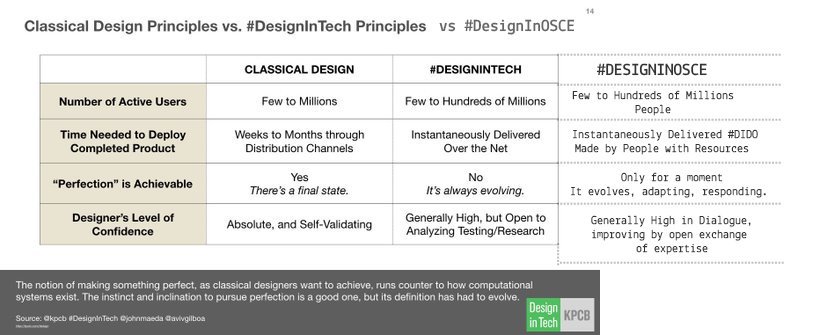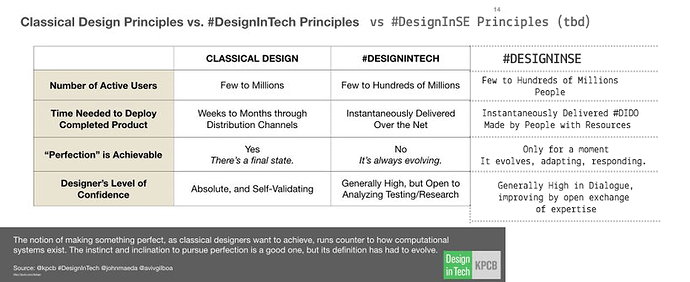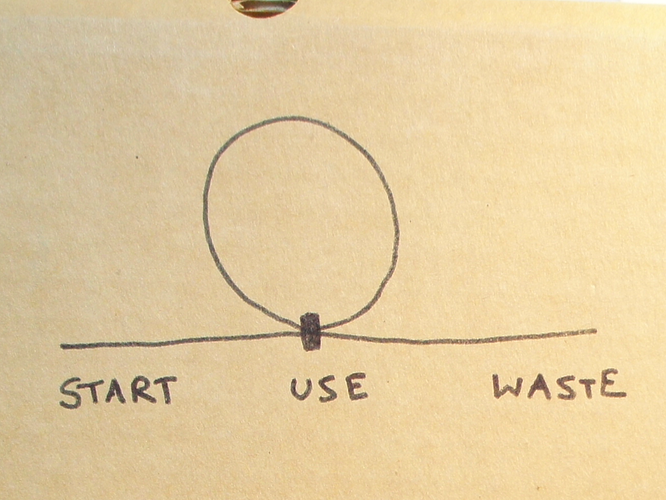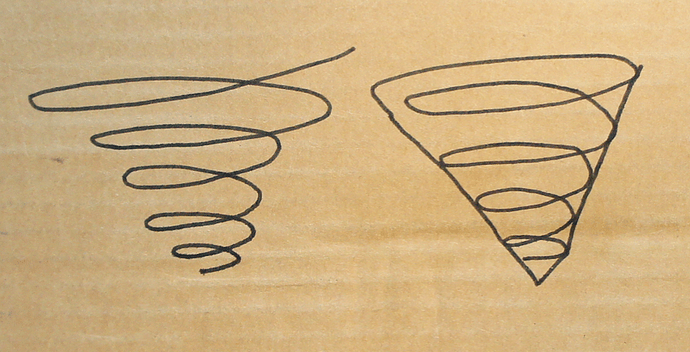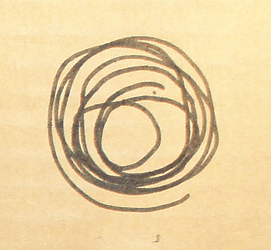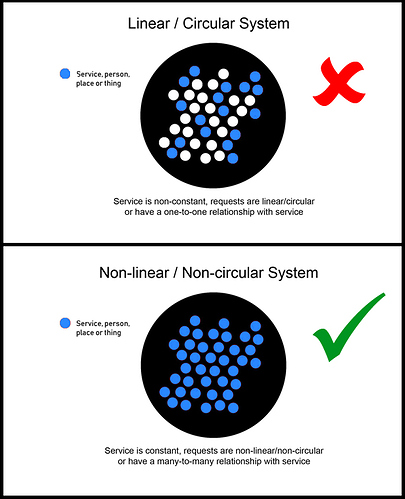@sharmarval (and @Lars2i) I think we shall join forces and move twds #SE (Spiral Economy aka @tomazdiez) tbd // Note: a lot of the ‘circular’ thinking stuff feels still too much like ‘Flatland’  literally kinda blah tbd
literally kinda blah tbd
move and join OSCE forces = #SE (Spiral Economy aka @tomasdiez tbd (beyond ‘circular’ ‘Flatland’  tbd
tbd
Classical Design Principles vs #DesignInTech Principles http://www.KPCB.com/blog/design-in-tech-report-2016 …
OSCE = yes, however drop C (beyond circle is spiral:) it’s open-with-value = > SE #SpiralEconomy
aka fibonacci style 
Quick copy of a definition @Silvia uses in her workshops. Maybe some of this can be edited in:
Industrial model designed and managed around circular flows of resources, products, processes that are
Renewable, long-lasting, high value
Low carbon, low entropy, low waste
Non-toxic, clean, nourishing, healthy
The concept was developed in industrial ecology and prescribes industry as a human-made ecosystem operating on the same principles as the natural ecosystem
###EMF has updated their definition
While I am on this again as promised I noticed that the EMF has changed their definition. I think it used to be:
“A circular economy is one that is restorative and regenerative by design, and which aims to keep products, components and materials at their highest utility and value at all times, distinguishing between technical and biological cycles.”
But now it is:
Looking beyond the current "take, make and dispose” extractive industrial model, the circular economy is restorative and regenerative by design. Relying on system-wide innovation, it aims to redefine products and services to design waste out, while minimising negative impacts. Underpinned by a transition to renewable energy sources, the circular model builds economic, natural and social capital.
As one of the reasons to create our own definition was that we did not like the one by the EMF … how is the new one?
Better, but I prefer our definition, we can adapt it to include people, but I insist that we use sustainable and synergy/symbiosis. If we are to use somebody else’s definition, let’s choose some other organization, non-corporate based.
Metabolic’s is better:
The circular economy is a new economic model for addressing human needs and fairly distributing resources without undermining the functioning of the biosphere or crossing any planetary boundaries.
##Definition Vs 0.3
Here are some thoughts and ideas on the definition. Written already in the shape of a blogpost. The text is also in my blog where it is much easier to read (better formatting).
META: The headlines are a summary or very short version. A suggestion for new definition is between large green bars in the second half of the text.
The OSCEdays Stewards are looking into creating a new definition for “Circular Economy” to build a base for the future. I was put in charge to push this project. And while I was on it I had some insights.
#The existing definitions do not reflect what we want.
Why do we want a new definition? Because we were not happy with the existing ones – provided by the Ellen MacArthur Foundation for example. They lack statements about sustainability and do not include social factors. They don’t represent what we want to work/fight for.
But what is this?
I think we should be clear, that the world and humanity can survive without a circular economy or sustainability. Sure, likely the planet will be much darker. But humans are good at getting used to things. And happy moments are possible even in weird circumstances. So it is not about “survival”.
But what we are for?
I think it is “beauty”. We want beauty! We want to live on a planet we find beautiful. But beauty is of course something subjective. Here is what I grasp is the common ground in our little open group on beauty:
-
We like a nature and biosphere that is rich in structure. What is alive in species and biotopes today we want to see alive also in the future. Free and abundant!
-
We are not afraid of complexity. And we think that being respectful, humble, open, caring and enabling to the things around us is key to this No 1.
-
We want a tolerant plural society in which humans can feel save and express themselves freely in a growing, complex, sustainable world.
The second point – being humble and caring – is a logical consequence of the first one – preserve diversity. The third one just restates number one and two for society.
So everything in one sentence: I think we want – and this is maybe our “circular economy” – a world:
###“… where systems are designed in order to let the possibilities for as many other systems grow – short and long term (biological and technical systems).”
The sentence might not be too good. But it is clear: It is about caring, thinking ahead (about consequences) and try not to undermine the ability to exist for all things on earth. And existing means to be able to develop.
I think this is what we want to see expressed in our definition of “Circular Economy”. (And we think “circular economy” is the right approach because a lot of the techniques that are usually connected to it look promising for this goal.)
#But What We Want is not necessarily best called “Circular” Economy.
But let’s step back for a moment and admit that with this we are creating maybe more a mission or vision statement than a definition. (Update: This is also true for the great CE definition of Metabolic ) And: If you agree so far – at least mostly – you have to admit: It does not make too much sense to call this “circular”.
This is also “circular” (graph 1):
Creation, Use 1, Use 2, Trash. One loop is already a “circle”.
And this circle indeed implies that the product arrives at the same point twice – the same facility or company. And this would really be about the consolidation of ownership, control and power of existing companies. And it is not difficult to argue that this is not necessarily about sustainability and enabling more diversity.
Is “circular economy” really the right term to express a vision of an enriched world?
#We should continue to say “Circular Economy”.
Stay with me for a moment in the argument. I will not end with suggesting to discard “Circular Economy” and replace it with a new term.
- This would not be smart! Establishing a new term is hard, unlikely and time, energy and resource intense.
- We would exclude ourselves from the existing and emerging political and economic debates around “Circular Economy” where change might become possible. We should rather continue to “hack into” those debates.
- Also it would be wasteful itself to throw away all the work that has gone into establishing “circular economy” and not try to work with it.
But just for the sake of insight follow me through the next paragraph:
#But take a moment to understand that “Spiral” or something like it is/could be better.
One idea for a better term to grasp what we want could be “spiral economy”. @Grit posted that idea on the OSCEdays forum quoting Tomas Diez and also people from Fablab Berlin used it when they told me about the Fab City project. A quick Google search brought this article by 100%Open up.
A spiral (or funnel) could better express that ideally each activity in the system increases the number of possibilities for everything after. There is constant change and iteration – to the better.
Each action increases the number of possibilities for all actors in the system.
Something like this could be very inspiring! If you think about something “circular” it does not sound like too much fun. It sounds like you have the same amount of things you had before. But “spiral” means you have more afterwards! This is probably more appealing to larger audiences! Mainstreamy!
But “spiral” doesn’t work too good either. It is not really catchy. Or logical. What is the “line” in the spiral? It is even less self explanatory than “circular economy”. It is not the poster child for a successful marketing campaign.
How about a “plus” … or “future” … “plurality” … “surplus” … “total options” … “emerging possibilities” . economy … Ah naargh! No! None of this is doing the job … (small update: see reprise for another idea)
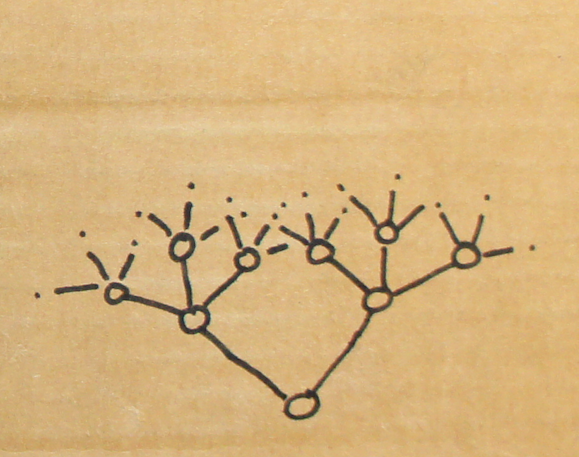
How to express the idea of growing options that do not harm existing options visually? Or even in words? I don’t know. This one is not doing the job either – But it would be great to have something that expresses the core idea: Do only something where you have a at least more than 2 or X good ideas what happens next with it. Always!
The term “Circular” economy isn’t perfect. But we would need a term that is magnitudes better in expressing our “idea of beauty” to make it worth wile and a probable success to push for a change. And it would be stupid to make the whole field more complicated with another term. So let’s stick with “circular” and try to load our ideas as meaning into it.
And this is somehow natural. Let’s jump to the next angle to look at this:
#So let’s Define our “Circular” Economy like a “Spiral” Economy.
If you look at this picture one more time (the circle with just one loop).
This is not a circular “economy”! It is a circular process! Or rather a circular step in an otherwise linear process.
An “economy” is something other than a single process. It is an immeasurable high number of processes that are dynamically intertwined with each other to an unbelievable degree of complexity! There is change all the time.
In a dynamic environment how to make sure that one process will be able to close a loop? You have to make it fit to connect to as many other processes as possible – so it get’s at least likely an actual loop is realized! The more connection options a process has the more likely it is that a connection can be found. If your output is “oxygen” you will be fine.
In other words: Your processes and systems need to be designed in a way that their outputs are useful for many other and different processes and systems. Or in even other words:
###“… in order to let the possibilities for as many other systems grow – short and long term (biological and technical systems).”
Because our economy is dynamic and complex this is the only viable strategy if you really want to make circles happen. And this is basically the same as our vision/idea of beauty 
And one strategy to make it likely that your process finds another one to connect is not to destroy other processes or systems – because this would undermine unexpected use®s. Add. Don’t take away.
And another strategy is of course Open Source – as it provides the information necessary to find a process and the legal opportunity to use it.
Ok. Well. Then let’s put all of this into our definition. And add open source right there. And make sure we are talking about a global circular economy. If we spin the definition like this it could turn out like this:
![]()
#Definition 0.3
A Circular Economy is an economy where systems are designed in order to let the possibilities for as many other systems grow as possible – short and long term (biological and technical systems).
To reach this goal it favors and explores – where it makes sense to reach it – concepts, techniques and strategies like:
- circular flows of resources, products and processes;
- fair and free environments for people to live and work;
- local and short feedback loops;
- use of standards;
- use of (non-toxic, clean, nourishing and healthy) materials that are either technically recyclable or biodegrade;
- products and processes designed for
- durability,
- compatibility,
- upgradability,
- adaptability,
- maintenance and repair and
- dis- and reassembly,
- (also high value);
- (Low carbon and low entropy approaches;)
- open source collaboration (or transparency).
![]()
The list is something to debate and the structure and language needs to be polished up, yes.
But how about the general spin? Could it work? Let people have this understanding when they think about “Circular Economy”.
What do you think?
###UPDATE: Reprise
(sorry there is a tiny more.)
A part of my brain of course still thinks about an alternative word for “circular”. I have another idea. I don’t advocate for it (it did not feel like a Eureka moment). But I still want to share it – because it is interesting!
The best replacement word I found so far is “Pre-Use” – The Pre-Use Economy. This is probably why I am so enthusiastic about the term ever since I heard it. It expresses the whole idea that you should have at least one other idea about an alternative future “use” of something before you start using it that is not throw it into the garbage. Pre-Use invites complexity and to think ahead and to think about others (because why should you be the one doing the next use?) It is a basic operation that can be spread to everything: You pre-use the planet and nature!
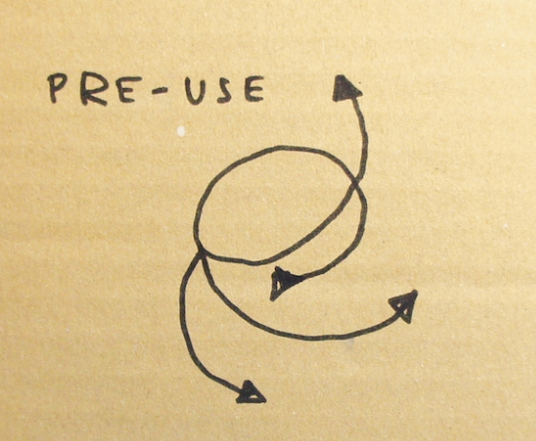
And what makes it so interesting: If everyone would include this BASIC OPERATION on a daily bases – for example in a shape like:
###Don’t do anything before you don’t have at least 3 positive ideas about what happens afterwards with it.
– a circular economy would emerge very quickly.°
–––
° The techniques and tools from the definition above would help to discover these 3 positive uses.
(And btw. IPO Tables could be a great tool to make this 3 positive ideas visible.)
ping @BoST
This – the Pre-Use Economy bit – reminds me a bit on the 2000 movie “Pay It Forward”
“In the movie the 12-year-old Trevor creates a plan that will change the world for the better. Trevor’s plan is a charitable program based on the networking of good deeds. He calls his plan “pay it forward”, which means the recipient of a favor does a favor for three others rather than paying the favor back.”
I like the idea of having such a “rule” in a definition. (It might be somehow the response to @Nikusha “wolf in the park” question.)
All the above will be a perfect introduction to our upcoming OSCE Guide to be published in 2018. I want to see this project through.
Great work Lars, this clearly has some key concepts we should hash out. I can’t offer a better definition right now but will mull on all this.
When I put out the post above I got a bunch of useful comments on Facebook that might be interesting for this. As you can’t link to posts on FB (which is one of the many reasons why it is a s**** platform) here copies of it:
#1
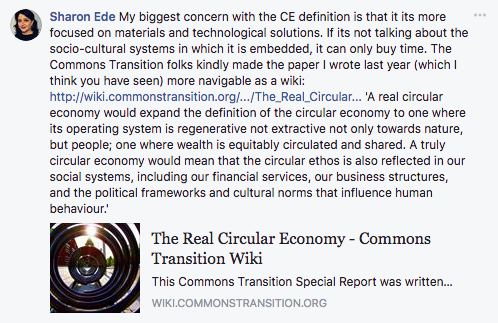
####LINK:
http://wiki.commonstransition.org/wiki/The_Real_Circular_Economy
#2

ENGLISH WIKIPEDIA LINK:
#3
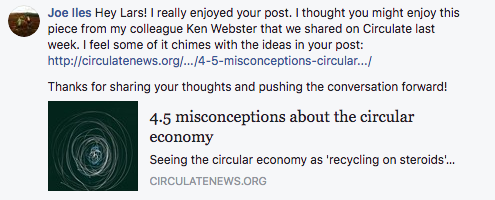
LINK:
http://circulatenews.org/2017/10/4-5-misconceptions-circular-economy/
#4
One more time Sharon, drilling on words.

LINK (Sustainments):
http://www.changedesign.org/Sustainments/What_are/WhatAreMain.htm
I just tidied up the language at the start of your version 0.3 a little to make it clearer and more readable - (I think) the concepts are still the same:
In a Circular Economy, systems are designed to provide the potential for as many other systems as possible to grow – in the short and long term (biological and technical systems).
To reach this goal, the Circular Economy favors and explores concepts, techniques and strategies like:
you could also change ‘biological and technical systems’ to ‘biological, social and technical systems’
Nice take on a definition from the World Resources Forum:
A circular economy aims at maintaining our resources, such as materials, land and soil, at a high quality level while rendering the services we need to fulfill our current and future needs. This can be achieved by reorganising production/consumption patterns and value chains so that resources do not get wasted, rather get replenished and restored.
Hi,
There is already a succinct definition for a linear or circular system written by Alan Turing in 1936, in his famous computable numbers paper.
Input > Process > Output (linear or circular equation)
What “we” need though, is not a linear or circular system or equation, it’s a non-linear or non-circular system or equation instead.
The above diagram, better explains the difference between a linear / circular system and non-linear / non-circular system. The blue and white dots in the linear / circular system can be viewed as a service, person, place or thing in the world. Some people or services don’t recognize that they are serving others, so they are white. The ones that do recognize that they are serving others are blue. As humankind, we need a circumstance where all of the dots are blue or are in the process of serving one another. The important part is the “in the process of serving”, because as humans we can program the ‘process of serving others’ or request elements of service, into a Turing machine or internet.
I’m currently working on an open source non-linear / non-circular system or platform at the moment. It presumes that all the dots are blue or serving each other and goes ahead and scales the inverse or request elements of the service being performed or conducted.
https://github.com/aletheon/eleutherios
The key thing that I discovered about a non-linear or non-circular system, is that service is constant, and it’s the request that is being scaled. As people, we are so use to it being the other way around.
Where service is linearized or circularized, or forced to be part of a one-to-one relationship with ‘a’ request, instead of a many-to-many relationship with ‘the’ request.
https://github.com/aletheon/eleutherios/blob/master/socioPoliticalEconomicProblem.pdf
The above storyboard expresses the dilemma that we are experiencing in our sociopolitical or economic domain of humankind, and how this dilemma can be transcended or gone beyond.
!DA
